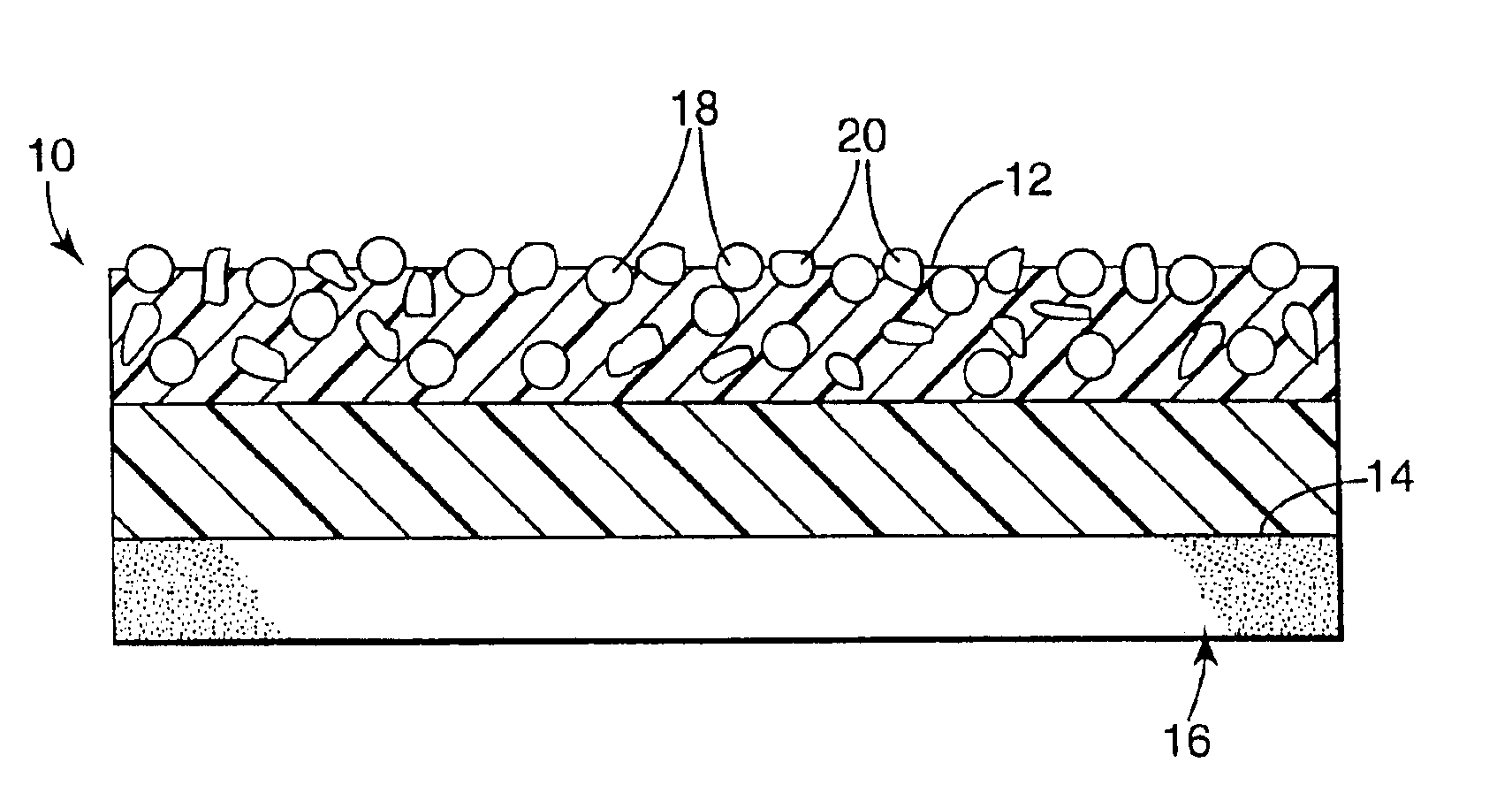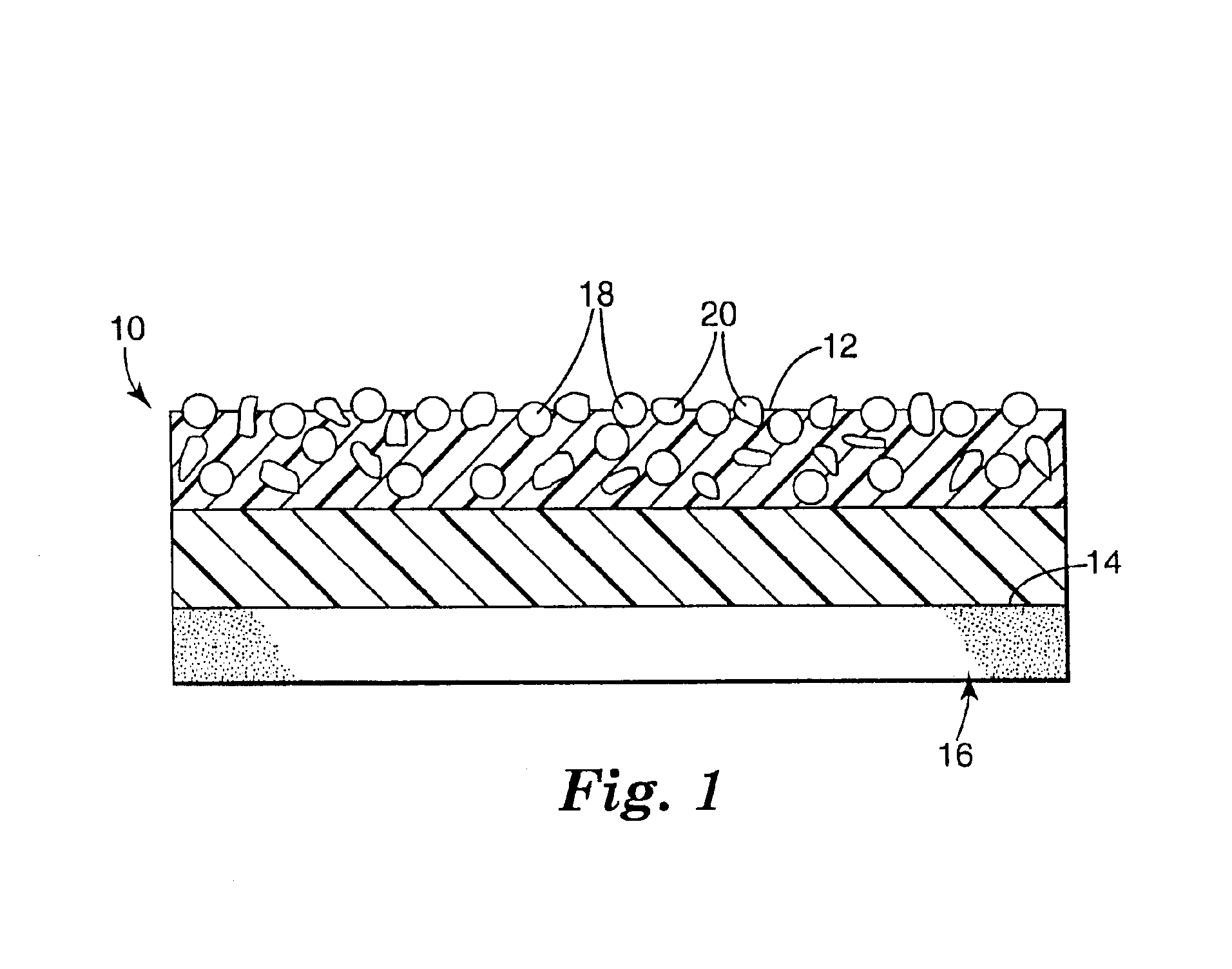Pavement marking article and raised pavement marker that uses pressure sensitive adhesive
a technology of pressure sensitive adhesive and pavement marker, which is applied in the direction of film/foil adhesives, roads, traffic signals, etc., can solve the problems of affecting the use of acrylic adhesives and the considerable challenge of road surfaces for adhesive attachment, and achieve the effect of avoiding negative environmental impa
- Summary
- Abstract
- Description
- Claims
- Application Information
AI Technical Summary
Benefits of technology
Problems solved by technology
Method used
Image
Examples
example 1
100 parts by weight of iso-octyl acrylate (IOA), isobornyl acrylate (IBA) and acrylic acid (AA) with a monomer ratio of 76 / 23 / 1 (IOA / IBA / AA) were blended with 0.04 parts of benzildimethylketal (KB-1, commercially available from Sartomer, Westchester, Pa.) photoinitiator, purged with nitrogen, and partially photopolymerized under an ultraviolet (UV) light source to yield an acrylate syrup having a viscosity of about 4000 centipoise (cPs). 0.16 parts of additional benzildimethylketal photoinitiator, 0.15 parts of 2,4-bis(trichloromethyl)-6-(4-methoxyphenyl), and 20 parts Regalrez™ 6108 tackifier resin were added to the acrylate syrup and mixed thoroughly until all of the components had completely dissolved. After mixing, the blend was knife-coated at a 254 μm (10 mils) thickness onto a silicone-treated polyethylene-coated paper release liner. The composite was then exposed to ultraviolet radiation having a spectral output from 300-400 nanometers (nm) with a maximum at 351 nm in a nitr...
example 2
A portion of the adhesive composition of Example 1 was laminated to a Stamark® 5760 backing (available from Minnesota Mining and Manufacturing). 4″×10′ samples of the adhesive coated backing were installed transverse to traffic on an unprimed asphalt substrate. Thirteen months later the samples were still intact.
example 3
An adhesive composition was prepared and applied to a Stamark® N420 backing according to the method described in Example 1 with the exception that the ratio of IOA / IBA / AA was 76 / 22 / 2 (IOA / IBA / AA). The adhesive coated backing was partitioned into three samples.
The three samples were subjected to the above described impact shear resistance test, except that the tires were driven across the surface of the test area at 8 revolutions / minute with 15 pounds per square inch (psi); 105 KPascals, downward pressure for the first 1000 hits after which the speed was ramped up to 60 revolutions / minute with 20 psi of downward pressure, which is equivalent to a linear tire speed of about 35 miles per hour. After 300,000 hits two of the three samples remained intact and undamaged. One of the three samples showed slight damage on the leading edge of the sample.
PUM
| Property | Measurement | Unit |
|---|---|---|
| flexural modulus | aaaaa | aaaaa |
| shear modulus | aaaaa | aaaaa |
| shear modulus | aaaaa | aaaaa |
Abstract
Description
Claims
Application Information
 Login to View More
Login to View More - R&D
- Intellectual Property
- Life Sciences
- Materials
- Tech Scout
- Unparalleled Data Quality
- Higher Quality Content
- 60% Fewer Hallucinations
Browse by: Latest US Patents, China's latest patents, Technical Efficacy Thesaurus, Application Domain, Technology Topic, Popular Technical Reports.
© 2025 PatSnap. All rights reserved.Legal|Privacy policy|Modern Slavery Act Transparency Statement|Sitemap|About US| Contact US: help@patsnap.com



